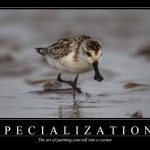Well, really, it seems that having same-sex relationships, which occur in at least 130 species of bird, might, in some cases, at least, “be adaptive, helping individuals defend territories, advance their social status, or get help with parental care,” or so says a recent study.
Let’s just hope the fundamentalist birds don’t find out about this and start trying to stop same-sex bird couples from marrying.













But isn’t marriage all about reproduction and not just love, defending a territory, and advance one’s social status?
I am clearly confused.
I totally read the title the wrong way. I read it as, “If I was gay, I could somehow help birds.”
Fascinating, Corey. Thanks.
Well, really,
temporary relationships….not long term ones
it seems that having same-sex relationships, which occur in at least 130 species of bird, might, in some cases, at least, “be adaptive, helping individuals defend territories, advance their social status
and in bisexual birds…well birds or snails
in the scarlet macaws I was working on, it was such that younger males formed same-sex pairs, thus elevating their social/hierarchical status. Young females tended to form loose flocks.
Fascinatingly, the social rank of an individual was not only dependent on who their partner was, but whether the partner was within 10ft of them. Females were typically of lower rank than males, unless they were paired with a high-ranking male (and the male was alongside them). Immature males in same-sex pairs were then typically of higher social rank than high-status females (with partner at a distance). Immature females in a group were also higher than the high-ranking adult female if her partner were not present.
As the young males reached sexual maturity, their same-sex partnerships started to loose their cement and slowly dissolved as they slowly developed stronger links with a potential mate. Eventually over a period of a good 6 months, the partners were “swopped out”.
Completely fascinating….
The parrotlets I worked on also often formed male-male pairs, complete with courtship behaviors and nest-site prospecting, as younger males. Very interesting behavior.
My question to those here who seem to know much of this subject is this: is the behavior of same-sex pairs limited to pair-bonding, nest-building, and other domestic demonstrations, or does sexual intercourse also occur?
Speaking only from parrotlets, I can’t remember seeing a male-male pair pseudocopulate. I’ve been trying to look it up in the literature but I haven’t found the right reference yet. I’ll let you know if I do.
I cannot remember seeing same-sex pseudocopulation behaviour either, although one pair certainly got cosy and excavated a nest together and sat in there for a very long time (but then I think with this pair, they were getting in to sexual maturity and had not found suitable mates yet – large parrots can be very very picky in their mate selection!). The next year, they had found mates and one pair bred successfully.